A Critical Analysis of Downward Communication Process Effectiveness
VerifiedAdded on 2023/06/12
|14
|4158
|328
Essay
AI Summary
This essay provides a reflective analysis of the downward communication process within a formal organizational structure, highlighting its characteristics, functions, and limitations. It discusses how information flows from top-level managers to subordinates, emphasizing the importance of openness and transparency. The essay also addresses problems such as information distortion and lack of feedback, comparing downward communication with horizontal communication, which allows for greater employee autonomy and feedback. The analysis concludes by suggesting that while downward communication ensures discipline and control, horizontal communication fosters better relationships and quicker information relay, ultimately impacting employee performance and organizational success. Desklib offers similar solved assignments and essays for students.
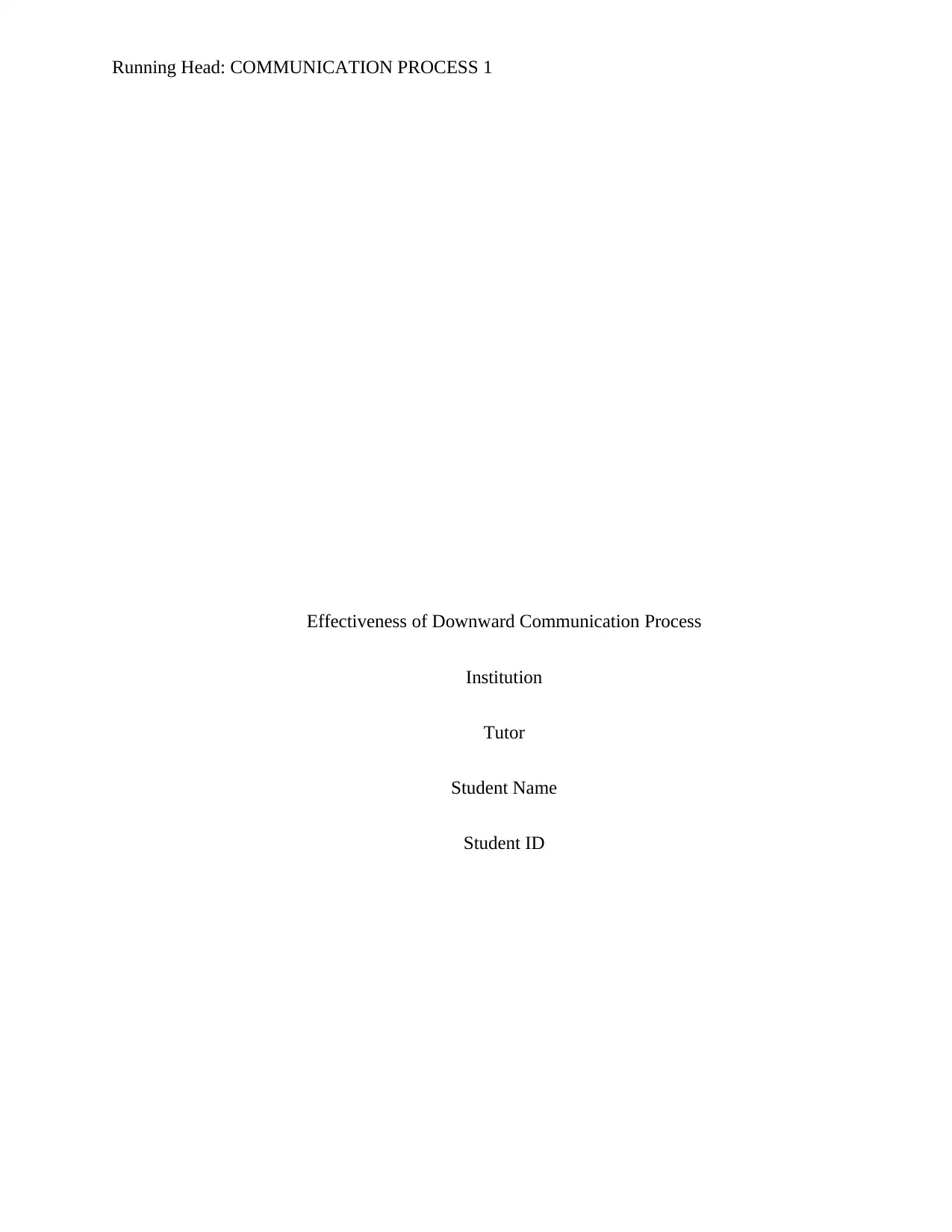
Running Head: COMMUNICATION PROCESS 1
Effectiveness of Downward Communication Process
Institution
Tutor
Student Name
Student ID
Effectiveness of Downward Communication Process
Institution
Tutor
Student Name
Student ID
Paraphrase This Document
Need a fresh take? Get an instant paraphrase of this document with our AI Paraphraser
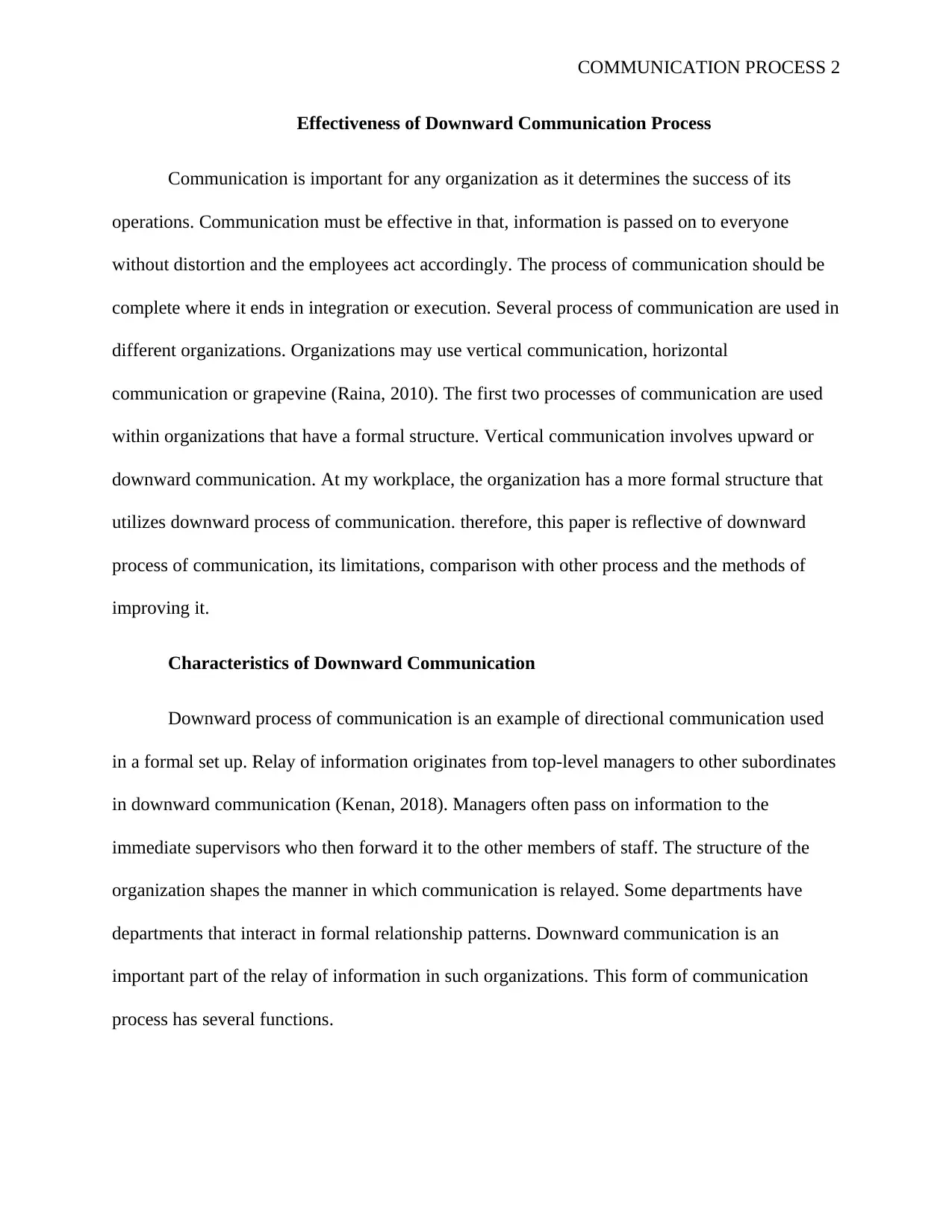
COMMUNICATION PROCESS 2
Effectiveness of Downward Communication Process
Communication is important for any organization as it determines the success of its
operations. Communication must be effective in that, information is passed on to everyone
without distortion and the employees act accordingly. The process of communication should be
complete where it ends in integration or execution. Several process of communication are used in
different organizations. Organizations may use vertical communication, horizontal
communication or grapevine (Raina, 2010). The first two processes of communication are used
within organizations that have a formal structure. Vertical communication involves upward or
downward communication. At my workplace, the organization has a more formal structure that
utilizes downward process of communication. therefore, this paper is reflective of downward
process of communication, its limitations, comparison with other process and the methods of
improving it.
Characteristics of Downward Communication
Downward process of communication is an example of directional communication used
in a formal set up. Relay of information originates from top-level managers to other subordinates
in downward communication (Kenan, 2018). Managers often pass on information to the
immediate supervisors who then forward it to the other members of staff. The structure of the
organization shapes the manner in which communication is relayed. Some departments have
departments that interact in formal relationship patterns. Downward communication is an
important part of the relay of information in such organizations. This form of communication
process has several functions.
Effectiveness of Downward Communication Process
Communication is important for any organization as it determines the success of its
operations. Communication must be effective in that, information is passed on to everyone
without distortion and the employees act accordingly. The process of communication should be
complete where it ends in integration or execution. Several process of communication are used in
different organizations. Organizations may use vertical communication, horizontal
communication or grapevine (Raina, 2010). The first two processes of communication are used
within organizations that have a formal structure. Vertical communication involves upward or
downward communication. At my workplace, the organization has a more formal structure that
utilizes downward process of communication. therefore, this paper is reflective of downward
process of communication, its limitations, comparison with other process and the methods of
improving it.
Characteristics of Downward Communication
Downward process of communication is an example of directional communication used
in a formal set up. Relay of information originates from top-level managers to other subordinates
in downward communication (Kenan, 2018). Managers often pass on information to the
immediate supervisors who then forward it to the other members of staff. The structure of the
organization shapes the manner in which communication is relayed. Some departments have
departments that interact in formal relationship patterns. Downward communication is an
important part of the relay of information in such organizations. This form of communication
process has several functions.
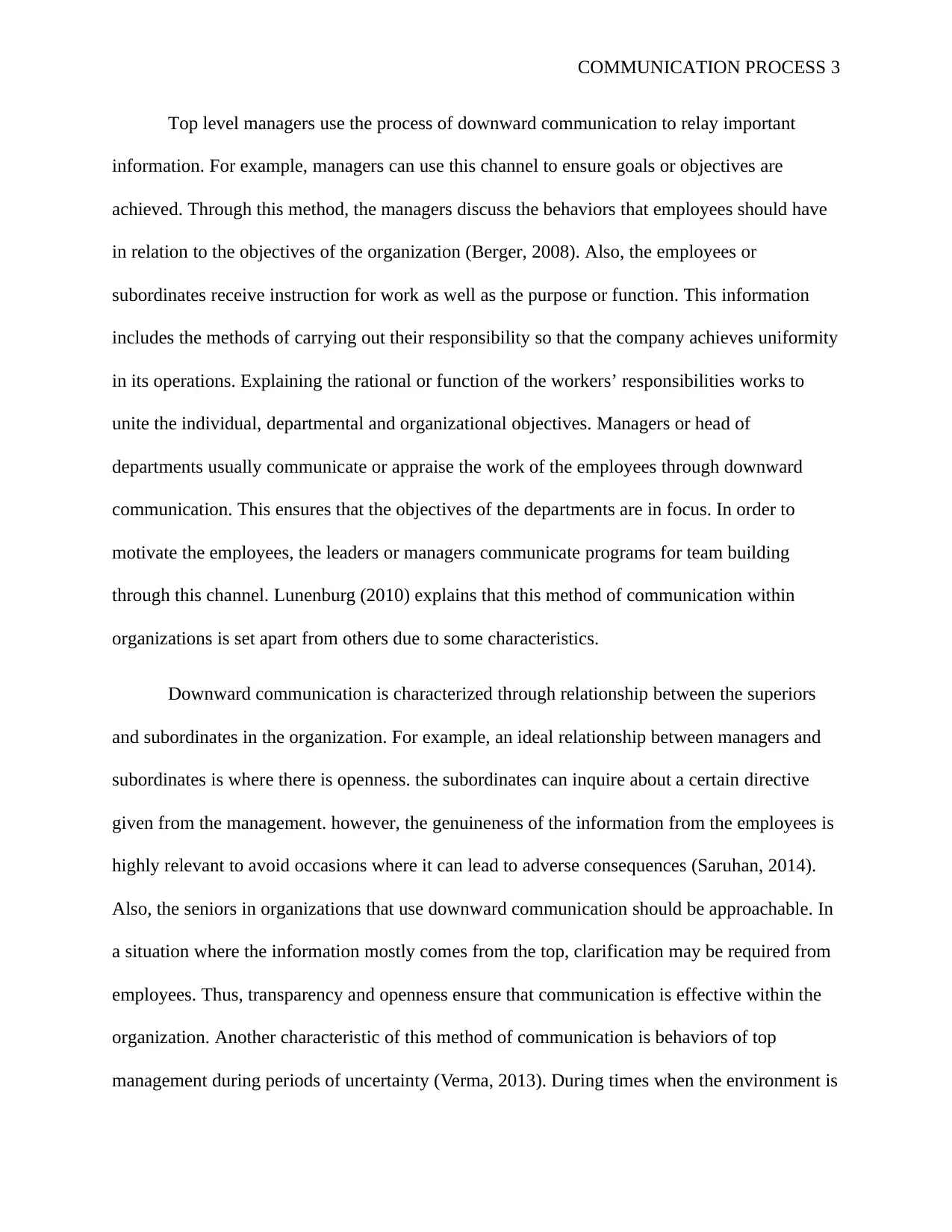
COMMUNICATION PROCESS 3
Top level managers use the process of downward communication to relay important
information. For example, managers can use this channel to ensure goals or objectives are
achieved. Through this method, the managers discuss the behaviors that employees should have
in relation to the objectives of the organization (Berger, 2008). Also, the employees or
subordinates receive instruction for work as well as the purpose or function. This information
includes the methods of carrying out their responsibility so that the company achieves uniformity
in its operations. Explaining the rational or function of the workers’ responsibilities works to
unite the individual, departmental and organizational objectives. Managers or head of
departments usually communicate or appraise the work of the employees through downward
communication. This ensures that the objectives of the departments are in focus. In order to
motivate the employees, the leaders or managers communicate programs for team building
through this channel. Lunenburg (2010) explains that this method of communication within
organizations is set apart from others due to some characteristics.
Downward communication is characterized through relationship between the superiors
and subordinates in the organization. For example, an ideal relationship between managers and
subordinates is where there is openness. the subordinates can inquire about a certain directive
given from the management. however, the genuineness of the information from the employees is
highly relevant to avoid occasions where it can lead to adverse consequences (Saruhan, 2014).
Also, the seniors in organizations that use downward communication should be approachable. In
a situation where the information mostly comes from the top, clarification may be required from
employees. Thus, transparency and openness ensure that communication is effective within the
organization. Another characteristic of this method of communication is behaviors of top
management during periods of uncertainty (Verma, 2013). During times when the environment is
Top level managers use the process of downward communication to relay important
information. For example, managers can use this channel to ensure goals or objectives are
achieved. Through this method, the managers discuss the behaviors that employees should have
in relation to the objectives of the organization (Berger, 2008). Also, the employees or
subordinates receive instruction for work as well as the purpose or function. This information
includes the methods of carrying out their responsibility so that the company achieves uniformity
in its operations. Explaining the rational or function of the workers’ responsibilities works to
unite the individual, departmental and organizational objectives. Managers or head of
departments usually communicate or appraise the work of the employees through downward
communication. This ensures that the objectives of the departments are in focus. In order to
motivate the employees, the leaders or managers communicate programs for team building
through this channel. Lunenburg (2010) explains that this method of communication within
organizations is set apart from others due to some characteristics.
Downward communication is characterized through relationship between the superiors
and subordinates in the organization. For example, an ideal relationship between managers and
subordinates is where there is openness. the subordinates can inquire about a certain directive
given from the management. however, the genuineness of the information from the employees is
highly relevant to avoid occasions where it can lead to adverse consequences (Saruhan, 2014).
Also, the seniors in organizations that use downward communication should be approachable. In
a situation where the information mostly comes from the top, clarification may be required from
employees. Thus, transparency and openness ensure that communication is effective within the
organization. Another characteristic of this method of communication is behaviors of top
management during periods of uncertainty (Verma, 2013). During times when the environment is
⊘ This is a preview!⊘
Do you want full access?
Subscribe today to unlock all pages.

Trusted by 1+ million students worldwide
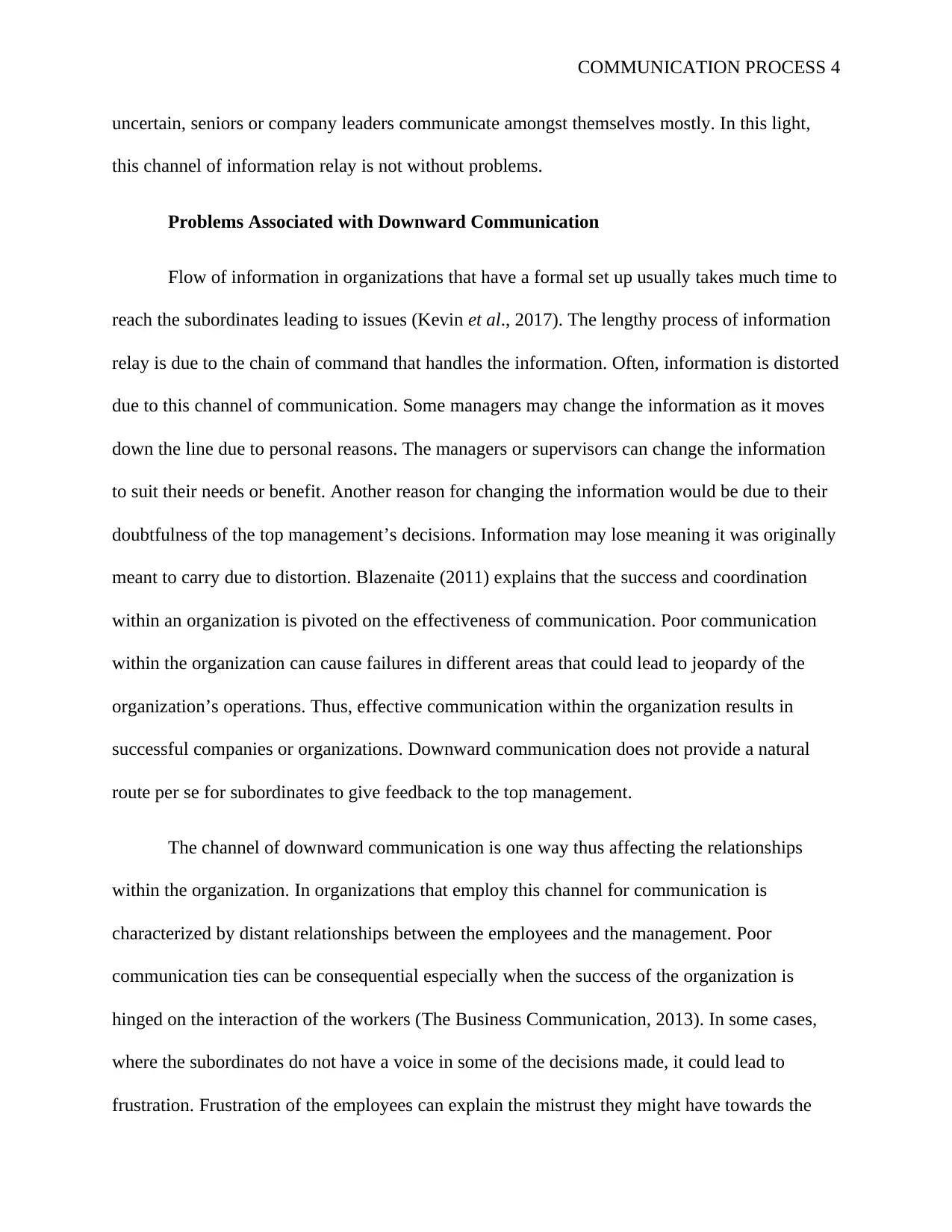
COMMUNICATION PROCESS 4
uncertain, seniors or company leaders communicate amongst themselves mostly. In this light,
this channel of information relay is not without problems.
Problems Associated with Downward Communication
Flow of information in organizations that have a formal set up usually takes much time to
reach the subordinates leading to issues (Kevin et al., 2017). The lengthy process of information
relay is due to the chain of command that handles the information. Often, information is distorted
due to this channel of communication. Some managers may change the information as it moves
down the line due to personal reasons. The managers or supervisors can change the information
to suit their needs or benefit. Another reason for changing the information would be due to their
doubtfulness of the top management’s decisions. Information may lose meaning it was originally
meant to carry due to distortion. Blazenaite (2011) explains that the success and coordination
within an organization is pivoted on the effectiveness of communication. Poor communication
within the organization can cause failures in different areas that could lead to jeopardy of the
organization’s operations. Thus, effective communication within the organization results in
successful companies or organizations. Downward communication does not provide a natural
route per se for subordinates to give feedback to the top management.
The channel of downward communication is one way thus affecting the relationships
within the organization. In organizations that employ this channel for communication is
characterized by distant relationships between the employees and the management. Poor
communication ties can be consequential especially when the success of the organization is
hinged on the interaction of the workers (The Business Communication, 2013). In some cases,
where the subordinates do not have a voice in some of the decisions made, it could lead to
frustration. Frustration of the employees can explain the mistrust they might have towards the
uncertain, seniors or company leaders communicate amongst themselves mostly. In this light,
this channel of information relay is not without problems.
Problems Associated with Downward Communication
Flow of information in organizations that have a formal set up usually takes much time to
reach the subordinates leading to issues (Kevin et al., 2017). The lengthy process of information
relay is due to the chain of command that handles the information. Often, information is distorted
due to this channel of communication. Some managers may change the information as it moves
down the line due to personal reasons. The managers or supervisors can change the information
to suit their needs or benefit. Another reason for changing the information would be due to their
doubtfulness of the top management’s decisions. Information may lose meaning it was originally
meant to carry due to distortion. Blazenaite (2011) explains that the success and coordination
within an organization is pivoted on the effectiveness of communication. Poor communication
within the organization can cause failures in different areas that could lead to jeopardy of the
organization’s operations. Thus, effective communication within the organization results in
successful companies or organizations. Downward communication does not provide a natural
route per se for subordinates to give feedback to the top management.
The channel of downward communication is one way thus affecting the relationships
within the organization. In organizations that employ this channel for communication is
characterized by distant relationships between the employees and the management. Poor
communication ties can be consequential especially when the success of the organization is
hinged on the interaction of the workers (The Business Communication, 2013). In some cases,
where the subordinates do not have a voice in some of the decisions made, it could lead to
frustration. Frustration of the employees can explain the mistrust they might have towards the
Paraphrase This Document
Need a fresh take? Get an instant paraphrase of this document with our AI Paraphraser
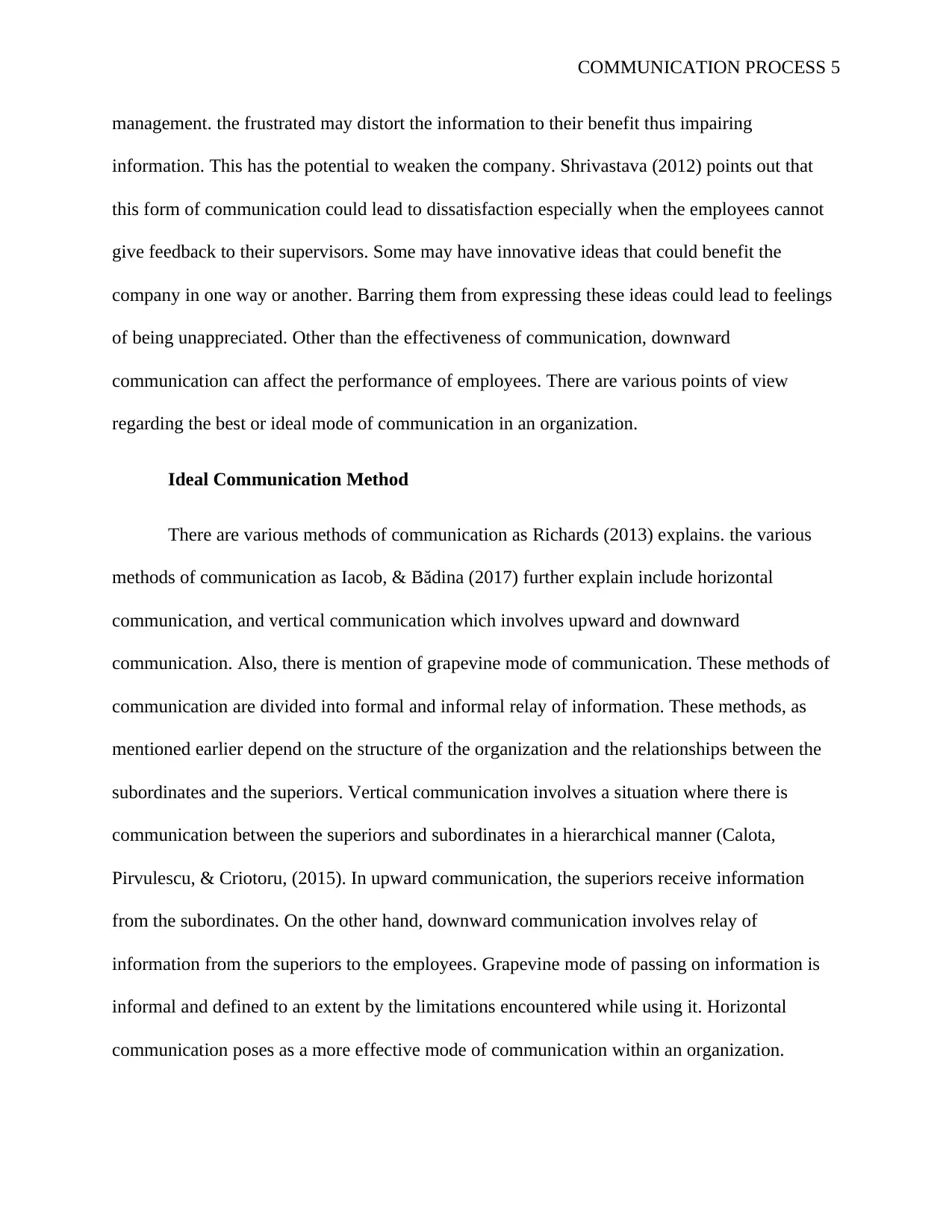
COMMUNICATION PROCESS 5
management. the frustrated may distort the information to their benefit thus impairing
information. This has the potential to weaken the company. Shrivastava (2012) points out that
this form of communication could lead to dissatisfaction especially when the employees cannot
give feedback to their supervisors. Some may have innovative ideas that could benefit the
company in one way or another. Barring them from expressing these ideas could lead to feelings
of being unappreciated. Other than the effectiveness of communication, downward
communication can affect the performance of employees. There are various points of view
regarding the best or ideal mode of communication in an organization.
Ideal Communication Method
There are various methods of communication as Richards (2013) explains. the various
methods of communication as Iacob, & Bădina (2017) further explain include horizontal
communication, and vertical communication which involves upward and downward
communication. Also, there is mention of grapevine mode of communication. These methods of
communication are divided into formal and informal relay of information. These methods, as
mentioned earlier depend on the structure of the organization and the relationships between the
subordinates and the superiors. Vertical communication involves a situation where there is
communication between the superiors and subordinates in a hierarchical manner (Calota,
Pirvulescu, & Criotoru, (2015). In upward communication, the superiors receive information
from the subordinates. On the other hand, downward communication involves relay of
information from the superiors to the employees. Grapevine mode of passing on information is
informal and defined to an extent by the limitations encountered while using it. Horizontal
communication poses as a more effective mode of communication within an organization.
management. the frustrated may distort the information to their benefit thus impairing
information. This has the potential to weaken the company. Shrivastava (2012) points out that
this form of communication could lead to dissatisfaction especially when the employees cannot
give feedback to their supervisors. Some may have innovative ideas that could benefit the
company in one way or another. Barring them from expressing these ideas could lead to feelings
of being unappreciated. Other than the effectiveness of communication, downward
communication can affect the performance of employees. There are various points of view
regarding the best or ideal mode of communication in an organization.
Ideal Communication Method
There are various methods of communication as Richards (2013) explains. the various
methods of communication as Iacob, & Bădina (2017) further explain include horizontal
communication, and vertical communication which involves upward and downward
communication. Also, there is mention of grapevine mode of communication. These methods of
communication are divided into formal and informal relay of information. These methods, as
mentioned earlier depend on the structure of the organization and the relationships between the
subordinates and the superiors. Vertical communication involves a situation where there is
communication between the superiors and subordinates in a hierarchical manner (Calota,
Pirvulescu, & Criotoru, (2015). In upward communication, the superiors receive information
from the subordinates. On the other hand, downward communication involves relay of
information from the superiors to the employees. Grapevine mode of passing on information is
informal and defined to an extent by the limitations encountered while using it. Horizontal
communication poses as a more effective mode of communication within an organization.
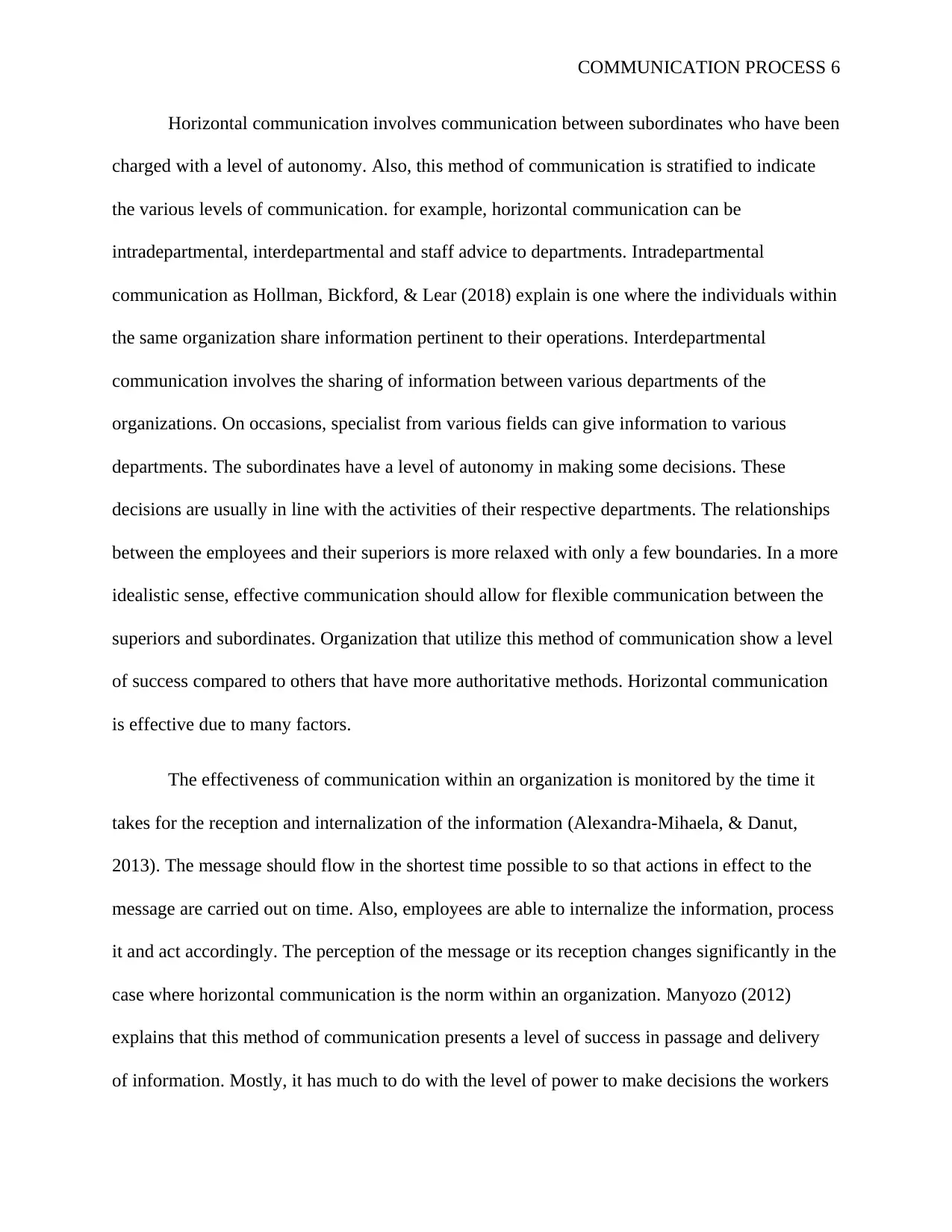
COMMUNICATION PROCESS 6
Horizontal communication involves communication between subordinates who have been
charged with a level of autonomy. Also, this method of communication is stratified to indicate
the various levels of communication. for example, horizontal communication can be
intradepartmental, interdepartmental and staff advice to departments. Intradepartmental
communication as Hollman, Bickford, & Lear (2018) explain is one where the individuals within
the same organization share information pertinent to their operations. Interdepartmental
communication involves the sharing of information between various departments of the
organizations. On occasions, specialist from various fields can give information to various
departments. The subordinates have a level of autonomy in making some decisions. These
decisions are usually in line with the activities of their respective departments. The relationships
between the employees and their superiors is more relaxed with only a few boundaries. In a more
idealistic sense, effective communication should allow for flexible communication between the
superiors and subordinates. Organization that utilize this method of communication show a level
of success compared to others that have more authoritative methods. Horizontal communication
is effective due to many factors.
The effectiveness of communication within an organization is monitored by the time it
takes for the reception and internalization of the information (Alexandra-Mihaela, & Danut,
2013). The message should flow in the shortest time possible to so that actions in effect to the
message are carried out on time. Also, employees are able to internalize the information, process
it and act accordingly. The perception of the message or its reception changes significantly in the
case where horizontal communication is the norm within an organization. Manyozo (2012)
explains that this method of communication presents a level of success in passage and delivery
of information. Mostly, it has much to do with the level of power to make decisions the workers
Horizontal communication involves communication between subordinates who have been
charged with a level of autonomy. Also, this method of communication is stratified to indicate
the various levels of communication. for example, horizontal communication can be
intradepartmental, interdepartmental and staff advice to departments. Intradepartmental
communication as Hollman, Bickford, & Lear (2018) explain is one where the individuals within
the same organization share information pertinent to their operations. Interdepartmental
communication involves the sharing of information between various departments of the
organizations. On occasions, specialist from various fields can give information to various
departments. The subordinates have a level of autonomy in making some decisions. These
decisions are usually in line with the activities of their respective departments. The relationships
between the employees and their superiors is more relaxed with only a few boundaries. In a more
idealistic sense, effective communication should allow for flexible communication between the
superiors and subordinates. Organization that utilize this method of communication show a level
of success compared to others that have more authoritative methods. Horizontal communication
is effective due to many factors.
The effectiveness of communication within an organization is monitored by the time it
takes for the reception and internalization of the information (Alexandra-Mihaela, & Danut,
2013). The message should flow in the shortest time possible to so that actions in effect to the
message are carried out on time. Also, employees are able to internalize the information, process
it and act accordingly. The perception of the message or its reception changes significantly in the
case where horizontal communication is the norm within an organization. Manyozo (2012)
explains that this method of communication presents a level of success in passage and delivery
of information. Mostly, it has much to do with the level of power to make decisions the workers
⊘ This is a preview!⊘
Do you want full access?
Subscribe today to unlock all pages.

Trusted by 1+ million students worldwide
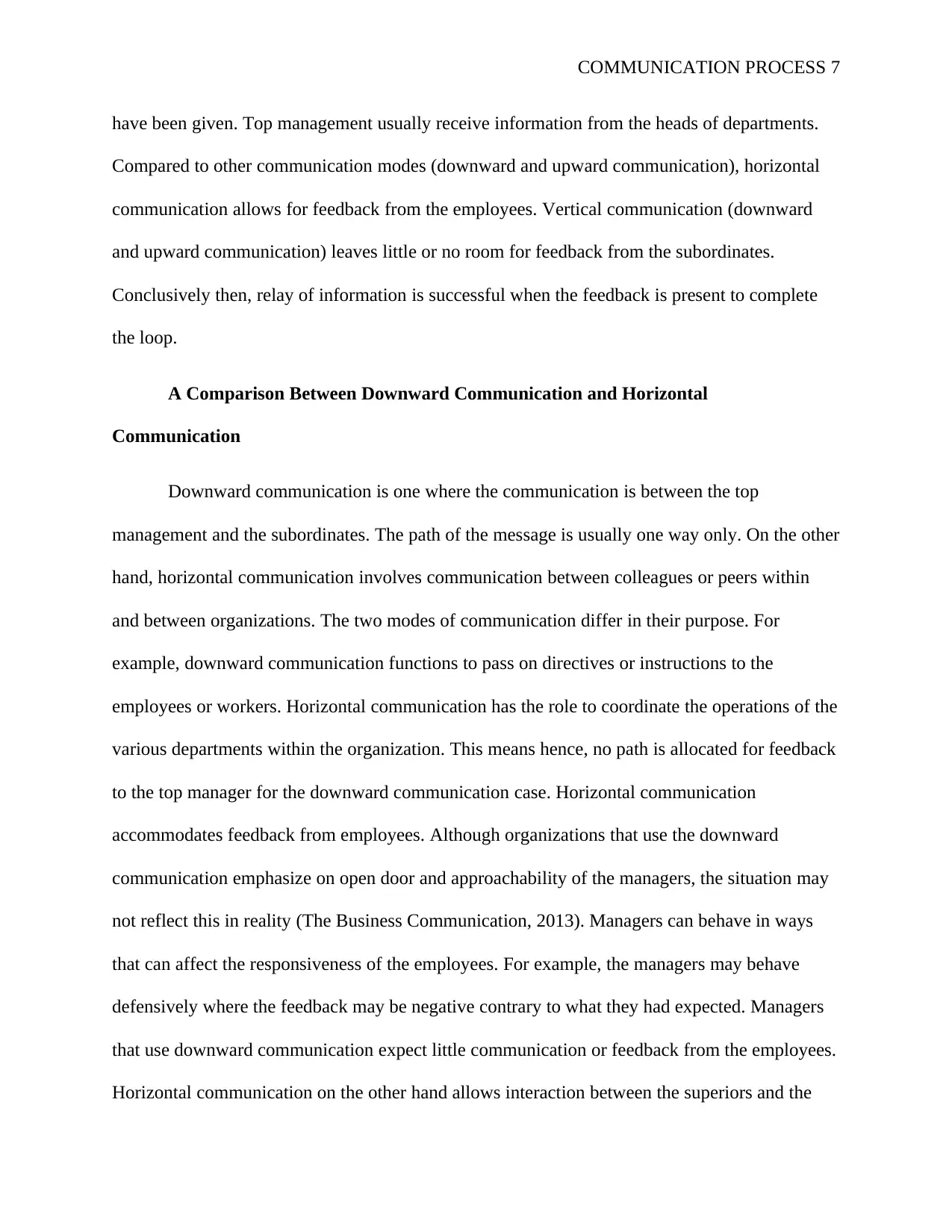
COMMUNICATION PROCESS 7
have been given. Top management usually receive information from the heads of departments.
Compared to other communication modes (downward and upward communication), horizontal
communication allows for feedback from the employees. Vertical communication (downward
and upward communication) leaves little or no room for feedback from the subordinates.
Conclusively then, relay of information is successful when the feedback is present to complete
the loop.
A Comparison Between Downward Communication and Horizontal
Communication
Downward communication is one where the communication is between the top
management and the subordinates. The path of the message is usually one way only. On the other
hand, horizontal communication involves communication between colleagues or peers within
and between organizations. The two modes of communication differ in their purpose. For
example, downward communication functions to pass on directives or instructions to the
employees or workers. Horizontal communication has the role to coordinate the operations of the
various departments within the organization. This means hence, no path is allocated for feedback
to the top manager for the downward communication case. Horizontal communication
accommodates feedback from employees. Although organizations that use the downward
communication emphasize on open door and approachability of the managers, the situation may
not reflect this in reality (The Business Communication, 2013). Managers can behave in ways
that can affect the responsiveness of the employees. For example, the managers may behave
defensively where the feedback may be negative contrary to what they had expected. Managers
that use downward communication expect little communication or feedback from the employees.
Horizontal communication on the other hand allows interaction between the superiors and the
have been given. Top management usually receive information from the heads of departments.
Compared to other communication modes (downward and upward communication), horizontal
communication allows for feedback from the employees. Vertical communication (downward
and upward communication) leaves little or no room for feedback from the subordinates.
Conclusively then, relay of information is successful when the feedback is present to complete
the loop.
A Comparison Between Downward Communication and Horizontal
Communication
Downward communication is one where the communication is between the top
management and the subordinates. The path of the message is usually one way only. On the other
hand, horizontal communication involves communication between colleagues or peers within
and between organizations. The two modes of communication differ in their purpose. For
example, downward communication functions to pass on directives or instructions to the
employees or workers. Horizontal communication has the role to coordinate the operations of the
various departments within the organization. This means hence, no path is allocated for feedback
to the top manager for the downward communication case. Horizontal communication
accommodates feedback from employees. Although organizations that use the downward
communication emphasize on open door and approachability of the managers, the situation may
not reflect this in reality (The Business Communication, 2013). Managers can behave in ways
that can affect the responsiveness of the employees. For example, the managers may behave
defensively where the feedback may be negative contrary to what they had expected. Managers
that use downward communication expect little communication or feedback from the employees.
Horizontal communication on the other hand allows interaction between the superiors and the
Paraphrase This Document
Need a fresh take? Get an instant paraphrase of this document with our AI Paraphraser
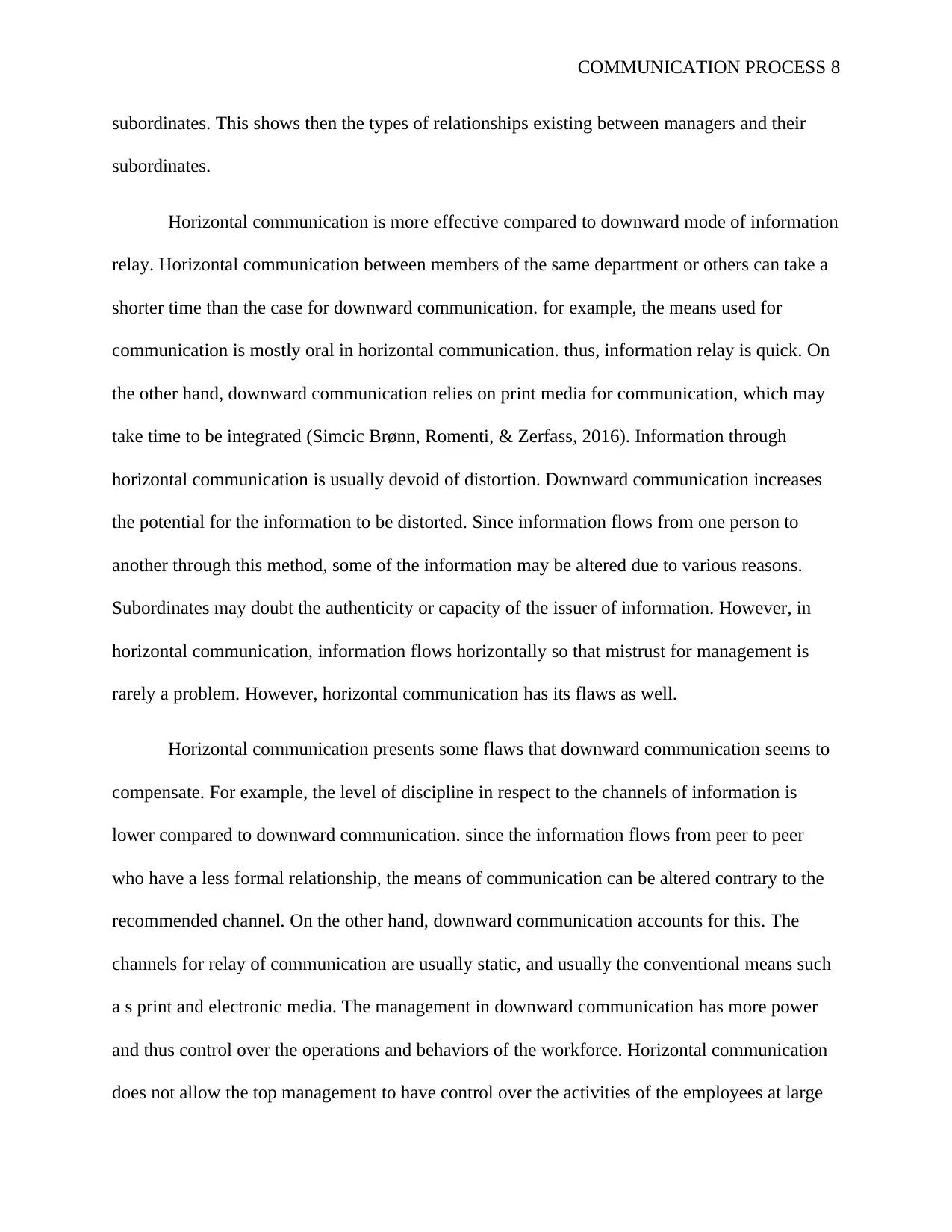
COMMUNICATION PROCESS 8
subordinates. This shows then the types of relationships existing between managers and their
subordinates.
Horizontal communication is more effective compared to downward mode of information
relay. Horizontal communication between members of the same department or others can take a
shorter time than the case for downward communication. for example, the means used for
communication is mostly oral in horizontal communication. thus, information relay is quick. On
the other hand, downward communication relies on print media for communication, which may
take time to be integrated (Simcic Brønn, Romenti, & Zerfass, 2016). Information through
horizontal communication is usually devoid of distortion. Downward communication increases
the potential for the information to be distorted. Since information flows from one person to
another through this method, some of the information may be altered due to various reasons.
Subordinates may doubt the authenticity or capacity of the issuer of information. However, in
horizontal communication, information flows horizontally so that mistrust for management is
rarely a problem. However, horizontal communication has its flaws as well.
Horizontal communication presents some flaws that downward communication seems to
compensate. For example, the level of discipline in respect to the channels of information is
lower compared to downward communication. since the information flows from peer to peer
who have a less formal relationship, the means of communication can be altered contrary to the
recommended channel. On the other hand, downward communication accounts for this. The
channels for relay of communication are usually static, and usually the conventional means such
a s print and electronic media. The management in downward communication has more power
and thus control over the operations and behaviors of the workforce. Horizontal communication
does not allow the top management to have control over the activities of the employees at large
subordinates. This shows then the types of relationships existing between managers and their
subordinates.
Horizontal communication is more effective compared to downward mode of information
relay. Horizontal communication between members of the same department or others can take a
shorter time than the case for downward communication. for example, the means used for
communication is mostly oral in horizontal communication. thus, information relay is quick. On
the other hand, downward communication relies on print media for communication, which may
take time to be integrated (Simcic Brønn, Romenti, & Zerfass, 2016). Information through
horizontal communication is usually devoid of distortion. Downward communication increases
the potential for the information to be distorted. Since information flows from one person to
another through this method, some of the information may be altered due to various reasons.
Subordinates may doubt the authenticity or capacity of the issuer of information. However, in
horizontal communication, information flows horizontally so that mistrust for management is
rarely a problem. However, horizontal communication has its flaws as well.
Horizontal communication presents some flaws that downward communication seems to
compensate. For example, the level of discipline in respect to the channels of information is
lower compared to downward communication. since the information flows from peer to peer
who have a less formal relationship, the means of communication can be altered contrary to the
recommended channel. On the other hand, downward communication accounts for this. The
channels for relay of communication are usually static, and usually the conventional means such
a s print and electronic media. The management in downward communication has more power
and thus control over the operations and behaviors of the workforce. Horizontal communication
does not allow the top management to have control over the activities of the employees at large
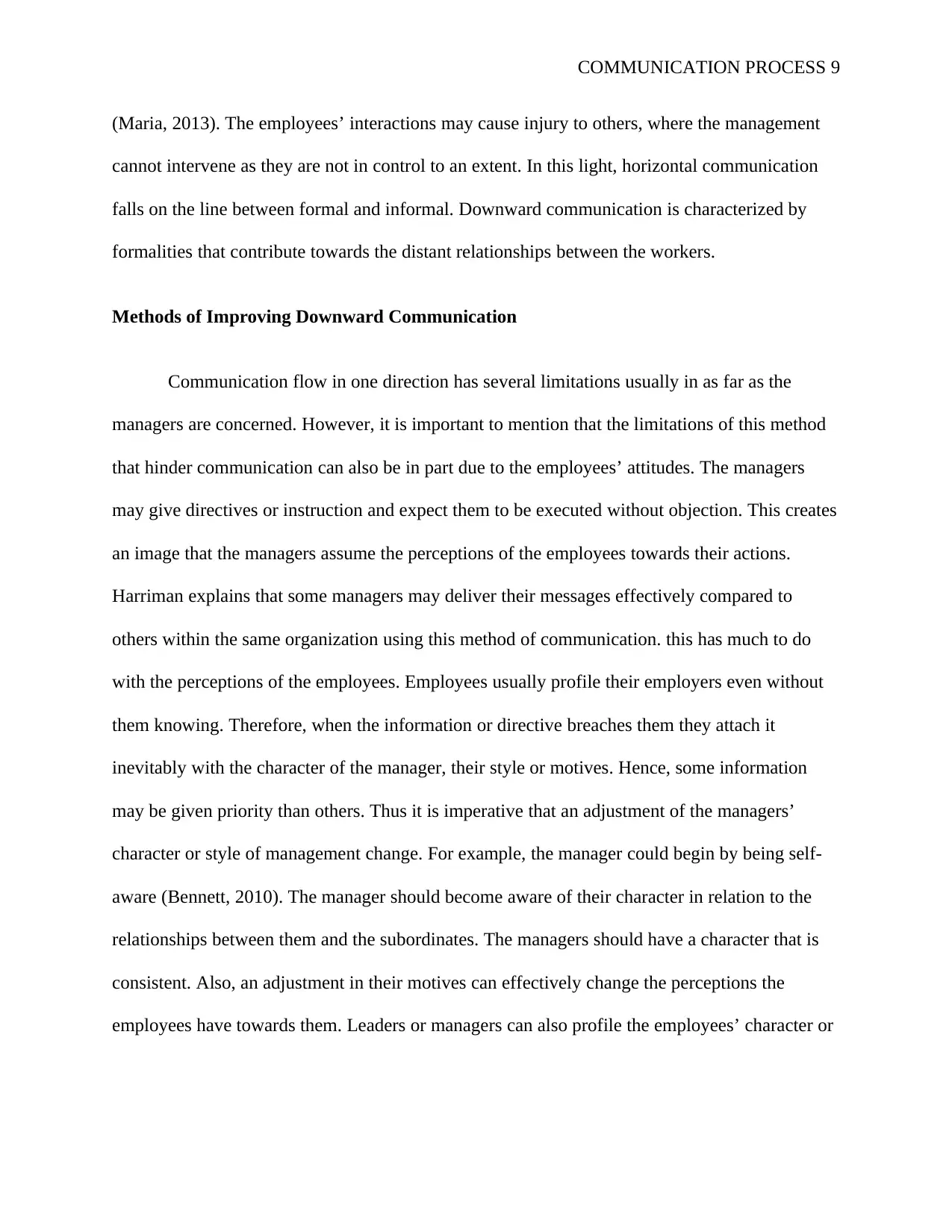
COMMUNICATION PROCESS 9
(Maria, 2013). The employees’ interactions may cause injury to others, where the management
cannot intervene as they are not in control to an extent. In this light, horizontal communication
falls on the line between formal and informal. Downward communication is characterized by
formalities that contribute towards the distant relationships between the workers.
Methods of Improving Downward Communication
Communication flow in one direction has several limitations usually in as far as the
managers are concerned. However, it is important to mention that the limitations of this method
that hinder communication can also be in part due to the employees’ attitudes. The managers
may give directives or instruction and expect them to be executed without objection. This creates
an image that the managers assume the perceptions of the employees towards their actions.
Harriman explains that some managers may deliver their messages effectively compared to
others within the same organization using this method of communication. this has much to do
with the perceptions of the employees. Employees usually profile their employers even without
them knowing. Therefore, when the information or directive breaches them they attach it
inevitably with the character of the manager, their style or motives. Hence, some information
may be given priority than others. Thus it is imperative that an adjustment of the managers’
character or style of management change. For example, the manager could begin by being self-
aware (Bennett, 2010). The manager should become aware of their character in relation to the
relationships between them and the subordinates. The managers should have a character that is
consistent. Also, an adjustment in their motives can effectively change the perceptions the
employees have towards them. Leaders or managers can also profile the employees’ character or
(Maria, 2013). The employees’ interactions may cause injury to others, where the management
cannot intervene as they are not in control to an extent. In this light, horizontal communication
falls on the line between formal and informal. Downward communication is characterized by
formalities that contribute towards the distant relationships between the workers.
Methods of Improving Downward Communication
Communication flow in one direction has several limitations usually in as far as the
managers are concerned. However, it is important to mention that the limitations of this method
that hinder communication can also be in part due to the employees’ attitudes. The managers
may give directives or instruction and expect them to be executed without objection. This creates
an image that the managers assume the perceptions of the employees towards their actions.
Harriman explains that some managers may deliver their messages effectively compared to
others within the same organization using this method of communication. this has much to do
with the perceptions of the employees. Employees usually profile their employers even without
them knowing. Therefore, when the information or directive breaches them they attach it
inevitably with the character of the manager, their style or motives. Hence, some information
may be given priority than others. Thus it is imperative that an adjustment of the managers’
character or style of management change. For example, the manager could begin by being self-
aware (Bennett, 2010). The manager should become aware of their character in relation to the
relationships between them and the subordinates. The managers should have a character that is
consistent. Also, an adjustment in their motives can effectively change the perceptions the
employees have towards them. Leaders or managers can also profile the employees’ character or
⊘ This is a preview!⊘
Do you want full access?
Subscribe today to unlock all pages.

Trusted by 1+ million students worldwide
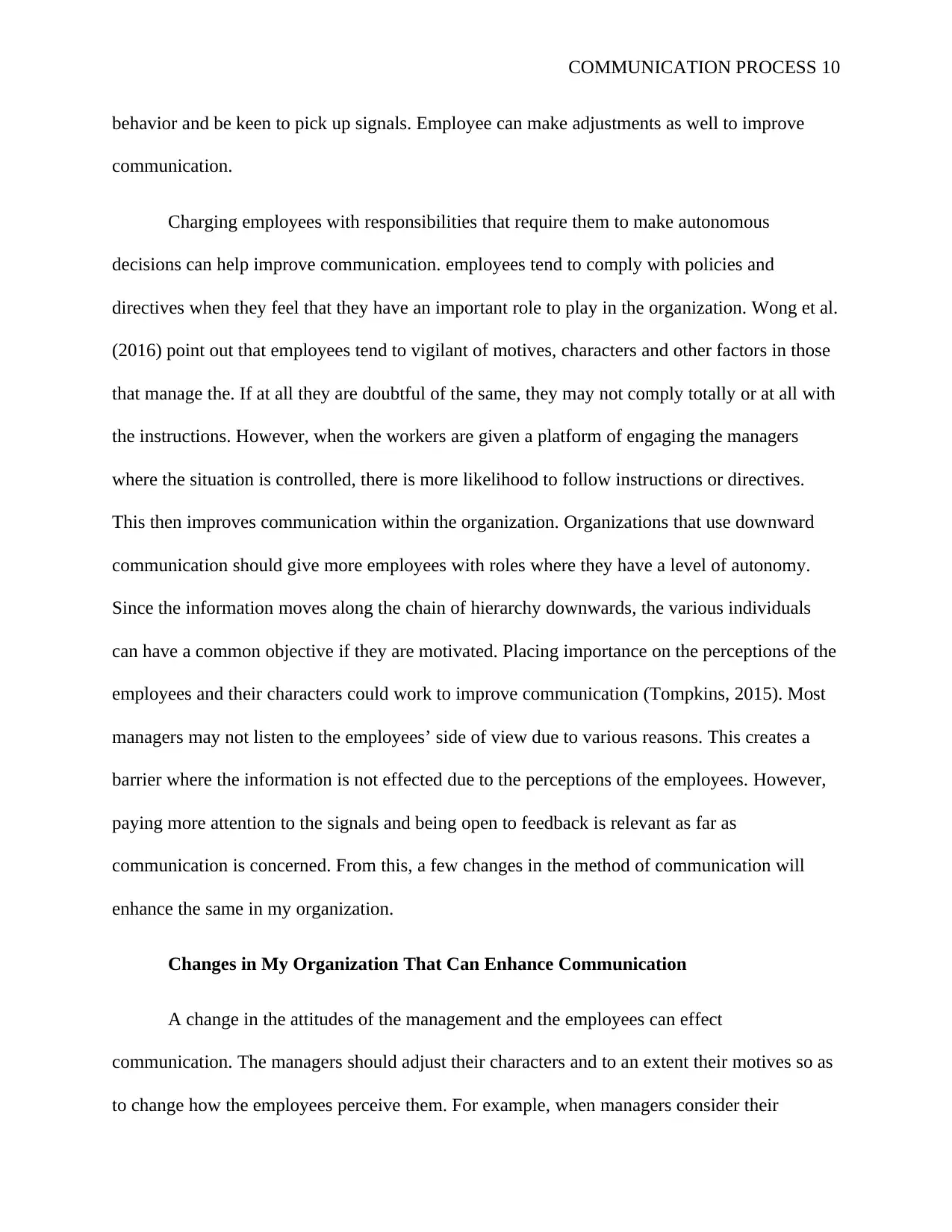
COMMUNICATION PROCESS 10
behavior and be keen to pick up signals. Employee can make adjustments as well to improve
communication.
Charging employees with responsibilities that require them to make autonomous
decisions can help improve communication. employees tend to comply with policies and
directives when they feel that they have an important role to play in the organization. Wong et al.
(2016) point out that employees tend to vigilant of motives, characters and other factors in those
that manage the. If at all they are doubtful of the same, they may not comply totally or at all with
the instructions. However, when the workers are given a platform of engaging the managers
where the situation is controlled, there is more likelihood to follow instructions or directives.
This then improves communication within the organization. Organizations that use downward
communication should give more employees with roles where they have a level of autonomy.
Since the information moves along the chain of hierarchy downwards, the various individuals
can have a common objective if they are motivated. Placing importance on the perceptions of the
employees and their characters could work to improve communication (Tompkins, 2015). Most
managers may not listen to the employees’ side of view due to various reasons. This creates a
barrier where the information is not effected due to the perceptions of the employees. However,
paying more attention to the signals and being open to feedback is relevant as far as
communication is concerned. From this, a few changes in the method of communication will
enhance the same in my organization.
Changes in My Organization That Can Enhance Communication
A change in the attitudes of the management and the employees can effect
communication. The managers should adjust their characters and to an extent their motives so as
to change how the employees perceive them. For example, when managers consider their
behavior and be keen to pick up signals. Employee can make adjustments as well to improve
communication.
Charging employees with responsibilities that require them to make autonomous
decisions can help improve communication. employees tend to comply with policies and
directives when they feel that they have an important role to play in the organization. Wong et al.
(2016) point out that employees tend to vigilant of motives, characters and other factors in those
that manage the. If at all they are doubtful of the same, they may not comply totally or at all with
the instructions. However, when the workers are given a platform of engaging the managers
where the situation is controlled, there is more likelihood to follow instructions or directives.
This then improves communication within the organization. Organizations that use downward
communication should give more employees with roles where they have a level of autonomy.
Since the information moves along the chain of hierarchy downwards, the various individuals
can have a common objective if they are motivated. Placing importance on the perceptions of the
employees and their characters could work to improve communication (Tompkins, 2015). Most
managers may not listen to the employees’ side of view due to various reasons. This creates a
barrier where the information is not effected due to the perceptions of the employees. However,
paying more attention to the signals and being open to feedback is relevant as far as
communication is concerned. From this, a few changes in the method of communication will
enhance the same in my organization.
Changes in My Organization That Can Enhance Communication
A change in the attitudes of the management and the employees can effect
communication. The managers should adjust their characters and to an extent their motives so as
to change how the employees perceive them. For example, when managers consider their
Paraphrase This Document
Need a fresh take? Get an instant paraphrase of this document with our AI Paraphraser
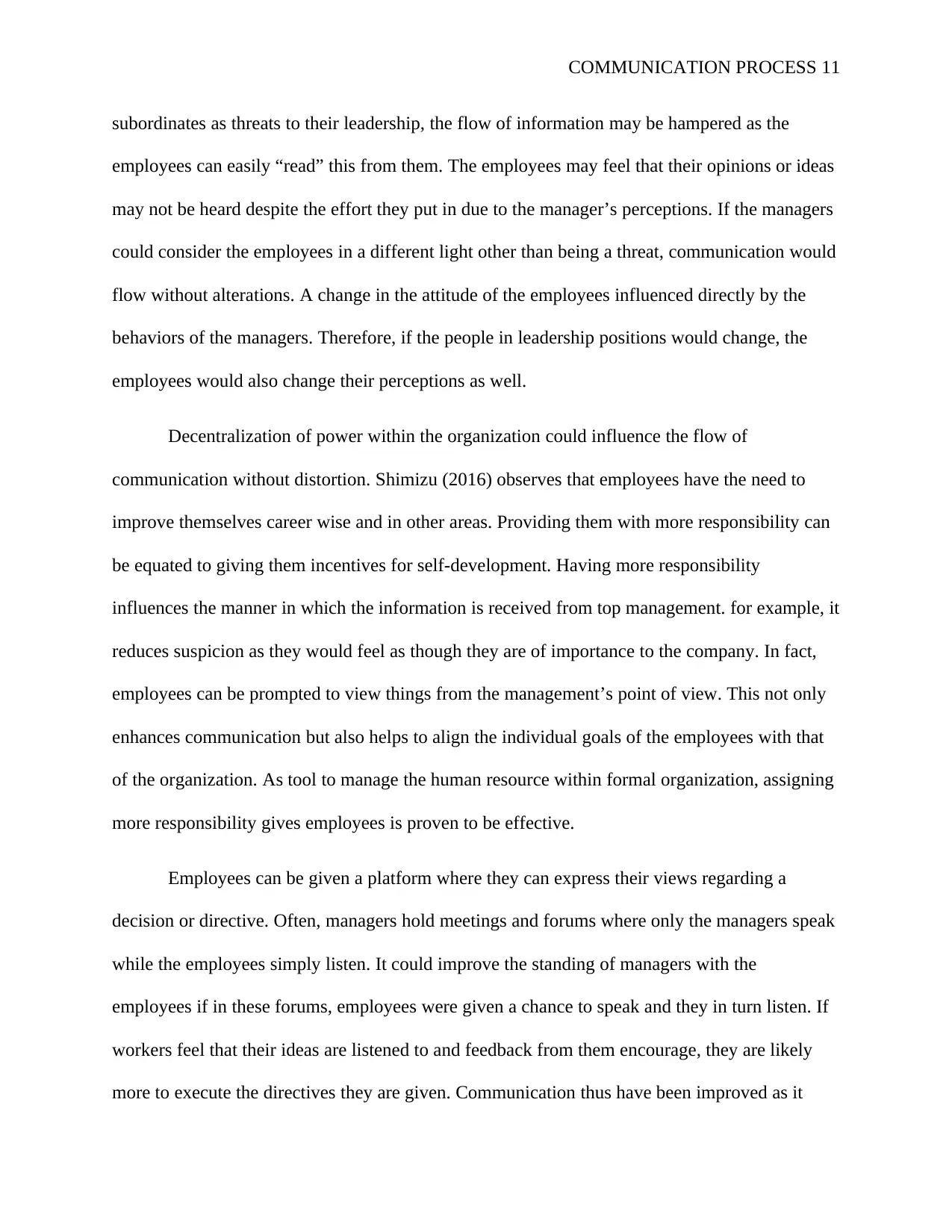
COMMUNICATION PROCESS 11
subordinates as threats to their leadership, the flow of information may be hampered as the
employees can easily “read” this from them. The employees may feel that their opinions or ideas
may not be heard despite the effort they put in due to the manager’s perceptions. If the managers
could consider the employees in a different light other than being a threat, communication would
flow without alterations. A change in the attitude of the employees influenced directly by the
behaviors of the managers. Therefore, if the people in leadership positions would change, the
employees would also change their perceptions as well.
Decentralization of power within the organization could influence the flow of
communication without distortion. Shimizu (2016) observes that employees have the need to
improve themselves career wise and in other areas. Providing them with more responsibility can
be equated to giving them incentives for self-development. Having more responsibility
influences the manner in which the information is received from top management. for example, it
reduces suspicion as they would feel as though they are of importance to the company. In fact,
employees can be prompted to view things from the management’s point of view. This not only
enhances communication but also helps to align the individual goals of the employees with that
of the organization. As tool to manage the human resource within formal organization, assigning
more responsibility gives employees is proven to be effective.
Employees can be given a platform where they can express their views regarding a
decision or directive. Often, managers hold meetings and forums where only the managers speak
while the employees simply listen. It could improve the standing of managers with the
employees if in these forums, employees were given a chance to speak and they in turn listen. If
workers feel that their ideas are listened to and feedback from them encourage, they are likely
more to execute the directives they are given. Communication thus have been improved as it
subordinates as threats to their leadership, the flow of information may be hampered as the
employees can easily “read” this from them. The employees may feel that their opinions or ideas
may not be heard despite the effort they put in due to the manager’s perceptions. If the managers
could consider the employees in a different light other than being a threat, communication would
flow without alterations. A change in the attitude of the employees influenced directly by the
behaviors of the managers. Therefore, if the people in leadership positions would change, the
employees would also change their perceptions as well.
Decentralization of power within the organization could influence the flow of
communication without distortion. Shimizu (2016) observes that employees have the need to
improve themselves career wise and in other areas. Providing them with more responsibility can
be equated to giving them incentives for self-development. Having more responsibility
influences the manner in which the information is received from top management. for example, it
reduces suspicion as they would feel as though they are of importance to the company. In fact,
employees can be prompted to view things from the management’s point of view. This not only
enhances communication but also helps to align the individual goals of the employees with that
of the organization. As tool to manage the human resource within formal organization, assigning
more responsibility gives employees is proven to be effective.
Employees can be given a platform where they can express their views regarding a
decision or directive. Often, managers hold meetings and forums where only the managers speak
while the employees simply listen. It could improve the standing of managers with the
employees if in these forums, employees were given a chance to speak and they in turn listen. If
workers feel that their ideas are listened to and feedback from them encourage, they are likely
more to execute the directives they are given. Communication thus have been improved as it
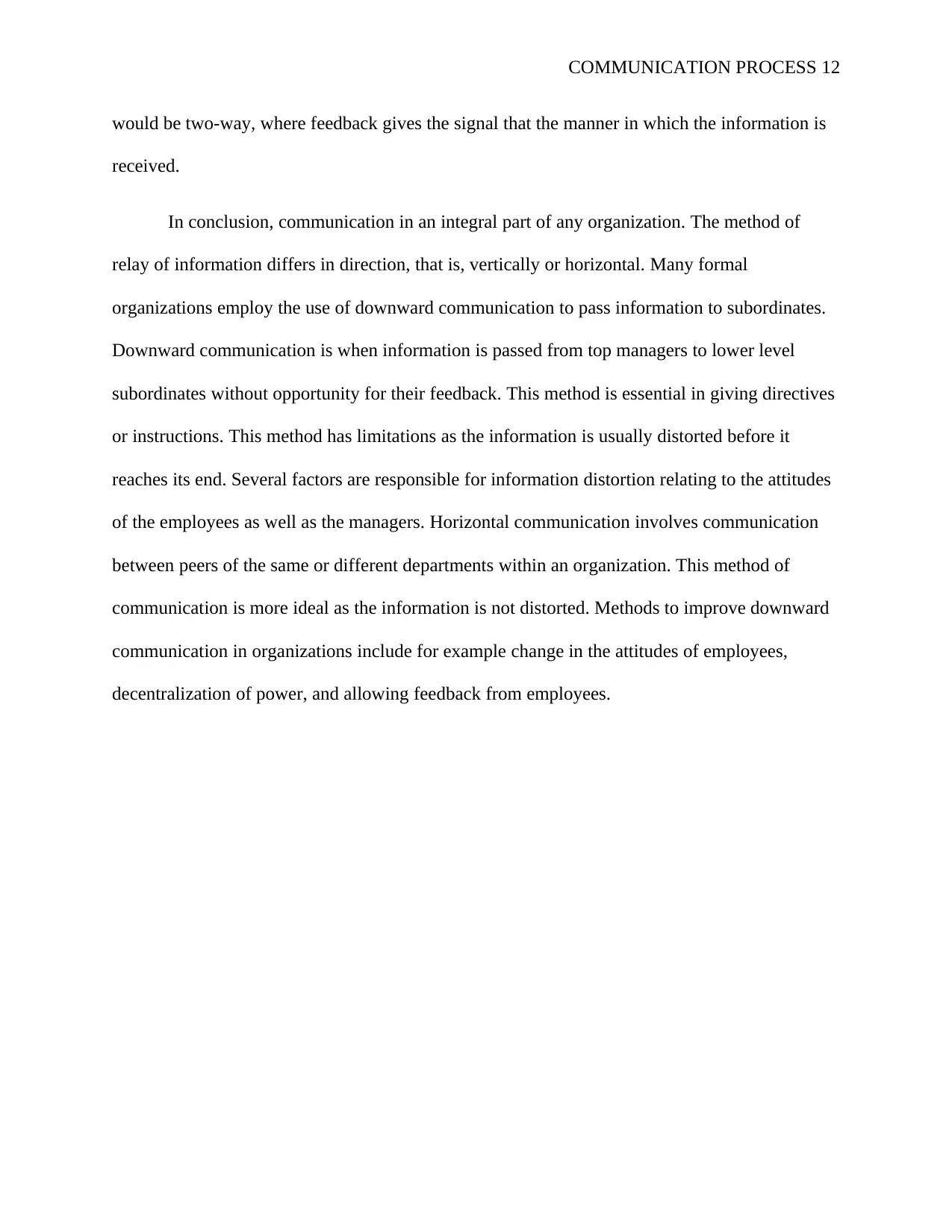
COMMUNICATION PROCESS 12
would be two-way, where feedback gives the signal that the manner in which the information is
received.
In conclusion, communication in an integral part of any organization. The method of
relay of information differs in direction, that is, vertically or horizontal. Many formal
organizations employ the use of downward communication to pass information to subordinates.
Downward communication is when information is passed from top managers to lower level
subordinates without opportunity for their feedback. This method is essential in giving directives
or instructions. This method has limitations as the information is usually distorted before it
reaches its end. Several factors are responsible for information distortion relating to the attitudes
of the employees as well as the managers. Horizontal communication involves communication
between peers of the same or different departments within an organization. This method of
communication is more ideal as the information is not distorted. Methods to improve downward
communication in organizations include for example change in the attitudes of employees,
decentralization of power, and allowing feedback from employees.
would be two-way, where feedback gives the signal that the manner in which the information is
received.
In conclusion, communication in an integral part of any organization. The method of
relay of information differs in direction, that is, vertically or horizontal. Many formal
organizations employ the use of downward communication to pass information to subordinates.
Downward communication is when information is passed from top managers to lower level
subordinates without opportunity for their feedback. This method is essential in giving directives
or instructions. This method has limitations as the information is usually distorted before it
reaches its end. Several factors are responsible for information distortion relating to the attitudes
of the employees as well as the managers. Horizontal communication involves communication
between peers of the same or different departments within an organization. This method of
communication is more ideal as the information is not distorted. Methods to improve downward
communication in organizations include for example change in the attitudes of employees,
decentralization of power, and allowing feedback from employees.
⊘ This is a preview!⊘
Do you want full access?
Subscribe today to unlock all pages.

Trusted by 1+ million students worldwide
1 out of 14
Related Documents
Your All-in-One AI-Powered Toolkit for Academic Success.
+13062052269
info@desklib.com
Available 24*7 on WhatsApp / Email
![[object Object]](/_next/static/media/star-bottom.7253800d.svg)
Unlock your academic potential
Copyright © 2020–2025 A2Z Services. All Rights Reserved. Developed and managed by ZUCOL.




